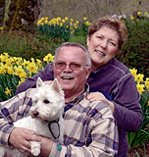
After two years of having three beautiful Rhode Island Red hens, they moved down the hill to Ted and Terry's-on a trial basis-we were going to be gone a lot and T&T wanted to see if having chickens worked for them-win/win situation. Well, T&T fell in love with "the girls" and "the girls" fell in love with the Taj Mahcoop. What hen wouldn't-automatic door opener-music-lights-what's not to love. Our coop is more like a Hampton Inn by comparison-cute but not very big-just your average English hen house.
So, here we are,Spring and NO CHICKENS-what to do? After a few phone calls I find someone who will have pullets by mid-June. But somewhere in the midst of my week I chat with my neighbor up the hill, Dana, who has raised baby chicks and just loves the whole process-for some reason I have never raised chicks-could I do that? We don't have a barn-our home is small-it could take some time-could be sort of messy-but it sounds like fun and Dennis thinks it could be fun too-HAVE WE LOST OUR MINDS OR WHAT! Cenex has plenty of chicks and we are going off-island anyway And I found and article in Cappers(Sept./Oct. 09) about building a chicken brooder out of three cardboard boxes and some strapping tape-how cool is that-IT MUST BE A SIGN-chicks are in our future! So, we are off to pick up chicks.
Well, we are home now with the new babies-they are so cute-Dennis and I are smitten. We invite neighbors in to meet them-we gaze at them tenderly-we tell our Westies that they must protect Their chicks-WE HAVE LOST OUR MINDS and this is FUN!

The brooder box went together so easily and is now part of the dining room furnishings, at least for the near future. The chicks settle in nicely-their chirping is so sweet and they are growing so fast-eat-sleep-poop-that's what's going on in the brooder box.
We have 3 golden Sexlinks, 5 black Sexlinks and 2 Leghorns. Sometimes we find them asleep in groups according to color. Other times, napping is fully integrated.

The next step will be outings on warm days in a portable coop and then the final move to the chicken coop.
I got double the number of chickens that I wanted to end up with, so just incase we lost some we'd still have enough to supply eggs for us and some to share. So far all are healthy and happy. We may end up with 10 hens or maybe a rooster or two.
Now, my next project is to find some old golf balls to put in the laying boxes.
HAPPY SPRING!





